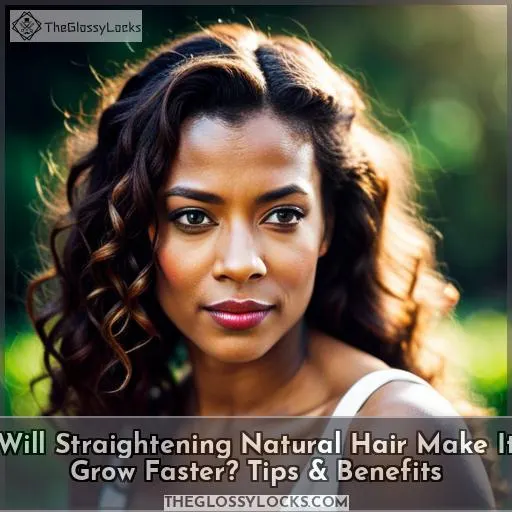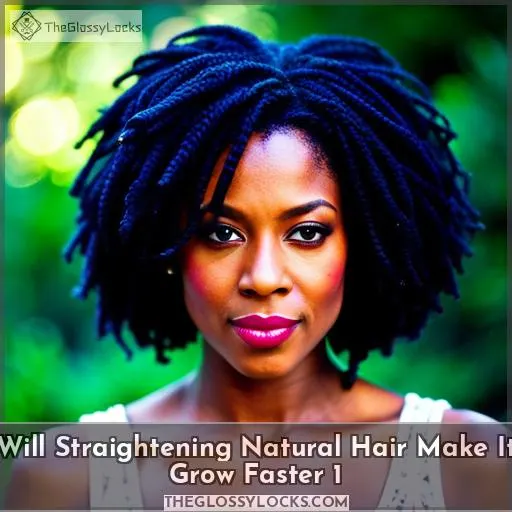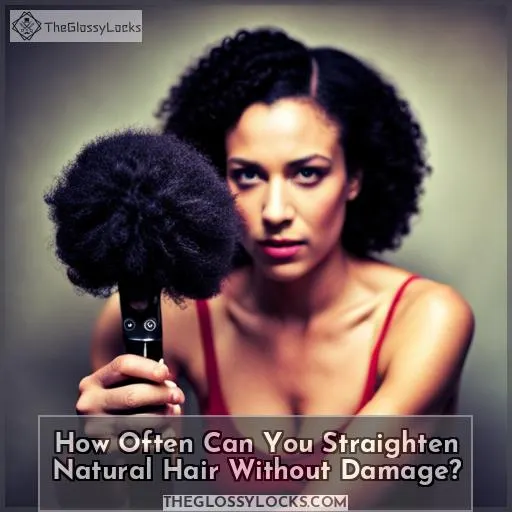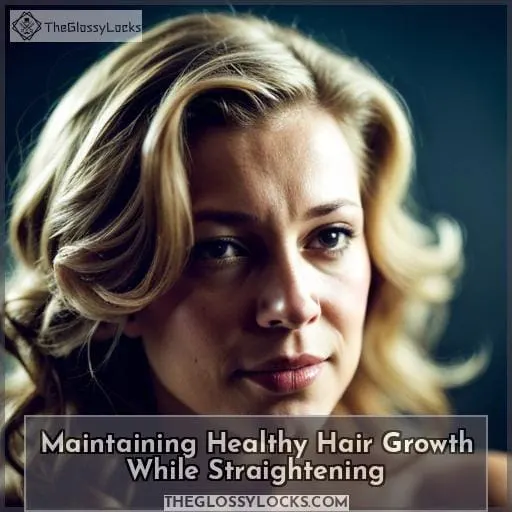This site is supported by our readers. We may earn a commission, at no cost to you, if you purchase through links.
 Are you looking for ways to grow your natural hair faster? Straightening may be one way to speed up the process, but does it really work? There’s a lot of misinformation out there about straightening natural hair, and understanding what is true and false can help you decide if this option could be beneficial for you.
Are you looking for ways to grow your natural hair faster? Straightening may be one way to speed up the process, but does it really work? There’s a lot of misinformation out there about straightening natural hair, and understanding what is true and false can help you decide if this option could be beneficial for you.
In this article, we’ll discuss whether or not straightening will make your natural hair grow faster, potential side effects of doing so, as well as benefits that come with it. We’ll also provide tips on how often to do so without causing damage and transitioning from chemically-straightened styles back into something more au naturel.
Table Of Contents
- Key Takeaways
- Does Straightening Natural Hair Promote Faster Growth?
- The Truth About Straightening Natural Hair
- Side Effects of Straightening Natural Hair
- Benefits of Straightening Natural Hair
- How Often Can You Straighten Natural Hair Without Damage?
- Transitioning From Chemically Straightened to Natural Hair
- Maintaining Healthy Hair Growth While Straightening
- Frequently Asked Questions (FAQs)
- What are the best heat protectants to use when straightening natural hair?
- Is there any way to prevent breakage when straightening natural hair?
- How can I transition from chemically straightened hair to natural hair safely?
- Are there any vitamins or supplements that can help promote natural hair growth?
- How often should I trim my natural hair when straightening it?
- Conclusion
Key Takeaways
- Straightening natural hair does not promote faster growth.
- Proper care and maintenance, including regular trims and deep conditioning, are crucial for healthy hair growth.
- Protective styling methods like braids or buns can reduce breakage and damage when straightening natural hair.
- Using heat protectants and minimizing heat styling frequency are important to prevent breakage and maintain hair health.
Does Straightening Natural Hair Promote Faster Growth?
There is no scientific evidence that suggests styling your tresses in a different way will accelerate their growth, however proper care and maintenance of your locks can certainly help keep them healthy and strong.
It is important to understand the porosity level of hair as it helps determine product application and conditioning frequency for optimal results.
Protective styling methods such as braids or buns are beneficial when trying to straighten natural hair, while regular trims ensure split ends do not damage the shaft further.
Heat protectants should be used prior to heat-styling processes such as flat ironing, blow drying, or curling irons which can cause breakage if done incorrectly with too much heat being applied at once.
Limiting this method of styling also protects from any damage occurring due to overprocessing with multiple sessions required for complete straightening.
Natural oils like coconut oil help maintain moisture levels while using heat, thus preventing dryness caused by excessive use. Following up consistently after every session also ensures scalp health stays intact without leading into more severe conditions like dandruff or irritation on sensitive skin types due to lackluster hydration routine post-straightening process.
Additionally, nourishing deep conditioners provide essential nutrients required to keep curls bouncy all day long, whilst providing added strength along the strands themselves, making them less prone towards future breaks during everyday activities involving brushing, etcetera.
Keeping a healthy balance between protective styles and occasional use of heated tools allows you freedom within choosing desired looks without having fear regarding potential risks associated with damaging effects usually seen in chemically treated hairs.
Nurturing instead emphasizing on frequent treatments featuring natural ingredients allow gradual changes to occur over time, transforming wild manes into manageable soft silky textures, presenting improved lengths than before, eventually rewarding those who have been patient enough throughout the entire duration spent caring toward their own personal crown jewels!
The Truth About Straightening Natural Hair
You may have heard of the notion that straightening natural hair will make it grow faster, but unfortunately, there is no scientific evidence to support this claim. However, with proper care and maintenance, you can keep your locks healthy and strong while allowing for versatility in styling without damaging chemicals or treatments.
Here are four things to consider when opting for straightening:
- Protective Styling – Braids or buns can be beneficial when trying to straighten natural hair as they reduce stress on strands from manipulation due to combing and brushing, which often leads to breakage over time.
- Heat Protectants – Prior heat-styling processes like blow-drying, flat ironing, or curling irons should always use a heat protectant product specifically designed for the scalp’s needs prior to application at high temperatures.
This would otherwise cause further damage if done incorrectly with too much heat being applied at once. - Porosity Level – Understanding how porous your mane is helps determine product application frequency as well as conditioning duration required so that optimal results are achieved each time without having fear regarding potential risks associated with damages usually seen in chemically treated hairs later on down the line.
- Hair Vitamins & Regular Trims – Consuming essential vitamins necessary helps promote healthier growth along the length itself, while regular trims ensure split ends do not become worse than what they already were before commencing any form of treatment whatsoever, whether it involves using heated tools such as heating plates, etc.
By following these steps carefully, you can achieve longer lengths safely by gradually transitioning into the desired look over a period of weeks/months, depending upon individual factors coexisting within the environment where tresses themselves reside! Nurturing instead of emphasizing frequent treatments featuring natural ingredients allows gradual changes to occur, transforming wild manes into manageable, soft, silky textures, presenting improved lengths rewarding those who have been patient enough throughout the entire duration spent caring toward their own personal crown jewels!
Side Effects of Straightening Natural Hair
Straightening natural hair can have a damaging effect on the hair shaft, ultimately leading to dry and brittle strands. Over-processing or straightening too often can cause breakage and thinning of the locks, making it more difficult for your mane to retain moisture.
It’s important to take care when using heat styling methods as they can be harsh on delicate tresses if not done properly.
Damage to the Hair Shaft
Straightening your locks can cause damage to the hair shaft, resulting in dryness and brittleness. Protecting the hair shaft is key when opting for straightening natural hair – using heat protectants and avoiding too much manipulation are important steps to take.
Understanding your own individual porosity level of the mane ensures proper product application, which helps minimize potential side effects that could be damaging over time if not handled with care.
Regular trims are an important source for keeping strands healthy throughout this journey, while scientific evidence demonstrates that there is no definitive answer regarding whether or not straightening makes it grow faster – but taking good care will promote longer lengths regardless!
With these points in mind, those looking to switch up their style without worrying about harsh chemicals or treatments should consider all aspects before making any decisions towards transformation!
Dry and Brittle Hair
Overprocessing your locks by straightening them multiple times can cause dryness and brittleness – leaving the mane feeling brittle to the touch. To avoid this, using heat protectants and opting for fewer styling sessions is key – as is understanding one’s own hair porosity level in order to apply products properly.
Protective styling methods such as braids or buns are also beneficial when it comes to reducing breakage, managing shrinkage, and improving blood circulation at the scalp level, which can help promote healthier growth in natural tresses! Furthermore, moisturizing tips should be taken into account when straightening.
The potential benefits of less product use alongside regular trims cannot be denied either – however, this does not mean that one’s hair will grow any faster! Still, though, with patience and a tailored plan designed specifically for each individual’s needs, healthy lengths are achievable without compromising on style choices.
Benefits of Straightening Natural Hair
You may be wondering about the advantages of straightening natural hair. Straightening can reduce frizz and make it easier to manage, improve scalp moisture absorption, and offer versatility in styling without using harsh chemicals or treatments.
With proper heat protection methods in place, you can enjoy these benefits while keeping your mane healthy and strong.
Reduced Frizz and Easier Manageability
By effectively managing your hair texture, you can reduce the amount of frizz and enjoy easier manageability without overprocessing. Protective styling with heat protectants is key for maintaining healthy hair when straightening natural locks.
Understanding your porosity level helps determine what product application works best and how often to condition the strands. Consuming a regular dose of vitamins such as biotin or collagen may also help in achieving longer, stronger tresses.
Regular trims are important for controlling tight curls, which tend to shrink more than loose waves. This will lead to a significant change in how much shrinkage you experience while promoting natural growth at its fullest potential! Straightening can be beneficial if done correctly by limiting heat exposure every 6-8 weeks, using wider plates on flat irons, and deep conditioning regularly.
Improved Scalp Moisture Absorption
By limiting heat exposure and introducing protective styling methods, you can improve the scalp’s ability to absorb and retain moisture for healthier tresses. Hair porosity is a key factor in understanding how often to trim your locks, as well as what products are best suited for them.
Introducing hair vitamins into your routine will help promote natural growth potential while reducing breakage from overprocessing. Additionally, protective styling with flat irons that have wider plates, along with regular deep conditioning, can help reduce shrinkage and extend the life of each hairstyle without damaging it further.
The never-ending task of caring for natural hair doesn’t have to be daunting when armed with knowledge on its porosity level and proper maintenance techniques! With patience comes great rewards – healthy tresses that reach their full potential under optimal conditions!
Versatility in Styling
Strapping on a flat iron and styling your hair can be like unlocking the door to an alternate universe of possibilities! Straightening natural hair offers many advantages, such as reduced frizz, improved manageability, and versatility in styling without damaging treatments or chemicals.
With protective styling methods, such as using heat protectants and wider plates for flat irons, you can reduce breakage from overprocessing. By implementing the correct techniques, you can achieve optimal results. Regular trims combined with deep conditioning will help maintain healthy locks that won’t shrink after straightening, allowing you to maintain its original length post-styling.
Hair porosity is also key when determining which products are best suited for your tresses. Incorporating vitamins into your routine will allow them to reach their full potential without damage or breakage hindering growth rate progressions.
How Often Can You Straighten Natural Hair Without Damage?
You can enjoy the benefits of heat styling your hair without damaging it, but it’s important to be mindful about how often you straighten.
- Use heat protectants before using any flat iron or curling wand. This will help reduce damage from the high-temperature tools while keeping your hair soft and smooth.
- Understand your hair’s porosity level as this helps determine product application and conditioning frequency for optimal results with minimal damage when straightening natural hair.
- A regular trim is essential in maintaining healthy locks – get one every 6-8 weeks!
- Protective styling methods like braids or buns can minimize manipulation of strands, which reduces breakage caused by daily combing through tangles that have been created from overprocessing due to frequent use of hot tools on the same area repeatedly within a short time span.
- Finally, supplementing with vitamins such as biotin may contribute towards fuller, healthier-looking tresses as well as boosting texture retention. It is part of the natural hair transition journey back to its original state, creating an illusion of length, whereas not necessarily making it grow faster directly.
Straightening natural hair can be a powerful way to get the look you want while maintaining the health of your mane in the midst of transition or reverting to curly texture from chemically straightened strands.
However, it’s important to be mindful to avoid overusing heat styling tools and seek alternatives in order to preserve your natural beauty and promote healthy growth that lasts long-term.
Transitioning From Chemically Straightened to Natural Hair
If you have been chemically straightening your hair for years and are now considering transitioning to embracing its natural texture, it can be a challenging but rewarding journey. To help make the process smoother and less daunting, understanding how to properly care for your hair during the transition is essential.
This involves cutting out or reducing chemical treatments, moisturizing the scalp regularly with products tailored towards individual needs such as porosity level, taking necessary vitamins for healthier hair growth like biotin supplements.
Accepting and Embracing Your Natural Hair
Accepting and embracing your unique hair texture is essential when transitioning from chemically straightened to natural locks, allowing you to enjoy the beauty of your own mane without worrying about damaging it.
Protecting hair with heat protectants before using any flat iron or curling wand, understanding its porosity level for optimal application of products and conditioning frequency, getting regular trims every 6-8 weeks, as well as taking hair growth vitamins, can help explosive new growth.
It’s also important to keep in mind that everyone has different preferences. Some may prefer their natural appearance while others may find styling tools part of their routine for a more polished look.
Even though there is no scientific evidence that straightening makes hair grow faster than naturally curly strands would have grown on their own rate over time, caring for the scalp and nourishing the roots remain key factors towards maintaining beautiful curls year-round!
Hair Care During the Transition
Consistent hair care is essential when transitioning from chemically straightened to natural locks. This includes regularly moisturizing the scalp, taking proper vitamins for growth, and protecting your strands with heat protectants.
Deep conditioning treatments can help restore moisture and elasticity, while protective styling methods such as braids or buns provide an extra layer of protection against damage caused by heat-styling tools.
Understanding your hair’s porosity level will also ensure that products are applied properly in order to maximize their benefits.
Heat protectants should always be used before using any flat iron or curling wand, so you don’t cause unnecessary damage when straightening natural tresses.
Long story short: although there isn’t a scientific answer as to whether straightening makes hair grow faster than its natural state, regular maintenance practices go a long way towards healthy locks – without sacrificing style!
Maintaining Healthy Hair Growth While Straightening
Keeping your tresses healthy and strong while heat styling requires taking the right steps to avoid damage. To ensure that your hair is not over-processed, use flat irons with wider plates and apply heat protectants prior to using heated tools.
It’s also important to keep in mind that regular trims, deep conditioning treatments, and protective hairstyles are key for maintaining healthier locks when straightening. In addition, understanding one’s porosity level helps determine which product application works best as well as how often it should be conditioned or hydrated for optimal results.
To maximize scalp moisture retention needed for stronger strands when straightening natural hair:
- Try out a few different types of products designed specifically towards individual needs like low or high porosity levels.
- Use moisturizing shampoos instead of clarifying ones.
- Take vitamins such as biotin supplements meant to benefit hair growth.
- Incorporate protective styles during the process along with temporary methods such as satin bonnets & scarves at night time so you can still enjoy having fabulous looking tresses without worrying about potential breakage from everyday activities!
Remembering these tips will help make sure that you’re getting the most out of each session while keeping those luscious curls safe from harm – after all, they deserve proper care too! Ultimately though, no matter what method used (whether chemical-free or not), patience plays an essential role throughout this journey whether aiming for lengthier locks or simply embracing its natural texture – focusing on nurturing rather than styling always comes first!
Frequently Asked Questions (FAQs)
What are the best heat protectants to use when straightening natural hair?
Investigate the best heat protectants for straightening natural hair without damaging it. From silicones to oils, discover what works to keep your locks healthy and strong while still enjoying a sleek style.
Is there any way to prevent breakage when straightening natural hair?
You can prevent breakage when straightening natural hair by using heat protectants, reducing the frequency of heat styling, and regularly deep conditioning.
How can I transition from chemically straightened hair to natural hair safely?
Transitioning from chemically straightened hair to natural texture requires patience, care, and understanding. Avoid harsh chemicals, moisturize your scalp regularly, and take vitamins for healthy growth.
Are there any vitamins or supplements that can help promote natural hair growth?
Taking care of your natural hair can help promote healthy growth. Vitamins such as biotin, folic acid, and B-complex vitamins are known to support strong, healthy hair from the inside out. Additionally, products containing amino acids and herbal oils can nourish your scalp to encourage new growth.
How often should I trim my natural hair when straightening it?
Trimming your natural hair every 6-8 weeks while straightening it can help keep it healthy and strong. Regular trims prevent split ends, promote growth, and maintain the desired length. Heat protectant is also essential for minimizing damage from heat styling tools.
Conclusion
In conclusion, straightening natural hair can be beneficial for styling and reducing frizz. However, it’s important to understand that too much heat styling can cause damage and breakage. Overprocessing natural hair by straightening it multiple times can lead to more breakage and damage.
It’s important to recognize that the number of times you can straighten your hair before it gets damaged varies depending on individual factors and hair care practices. On average, heat styling should be limited to once every 6-8 weeks to minimize damage.
An interesting statistic to consider is that, although straightening natural hair can stretch it out and make it appear longer, the health of the hair is always more important. Taking the time to nurture and care for your hair with regular trims, deep conditioning, and protective styling methods can help you maintain healthy, strong, and longer hair growth.










